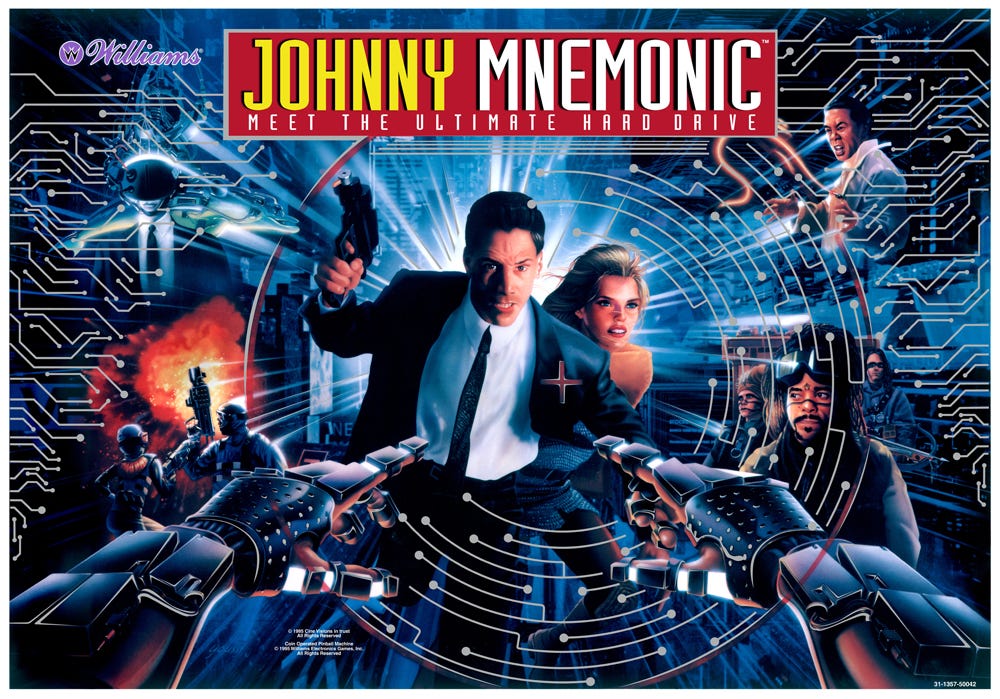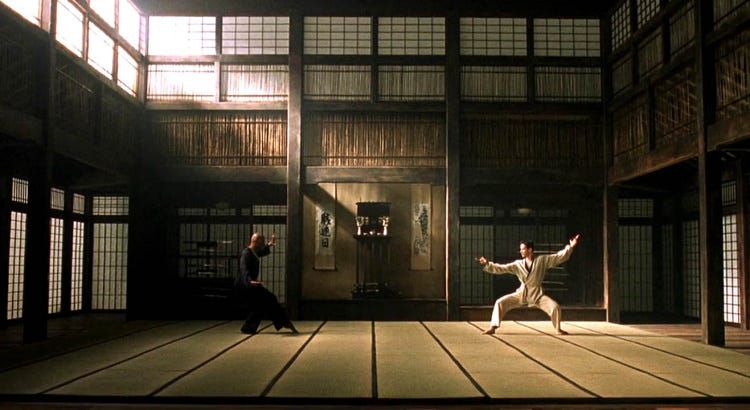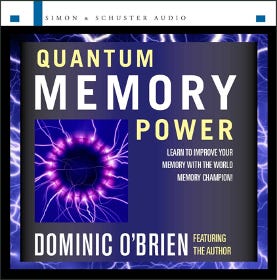Memory Tricks
Tools to help you remember things.
If you find this newsletter informative, please share it with other people you know!
A quick background
In general, my intent with this Substack is to help you better understand our world. Part of that comes from weekly news summaries that help you understand what’s happening right now, and another part comes from posts that help you understand the world through a different lens—in this case, we’re delving into geography.
In my first post in this series on geography, I provided an easy way to understand distances around the world by breaking it into three numbers—2,500; 3,000; and 4,000; the next phase will be learning the location of countries around the world.
But, before we jump into that, I want to first dedicate a post to the topic of memorization itself.
In the 1995 movie Johnny Mnemonic, Keanu Reeves plays a character that carries sensitive information in a storage device implanted in his head. Set in a dystopian future, Reeves character, transports the downloaded information at the cost of losing past memories.
I find that when trying to memorize large blocks of information through rote memorization—wherein I cram information into my brain through brute force repetition—that I feel like Johnny Mnemonic. Every bock of new information I add comes at the cost of something I learned previously.
Alternatively, I’m also reminded of another Keanu Reeves movie—The Matrix—where characters can quickly download skills and knowledge into their brain at no cost. There’s a famous scene where he quickly downloads martial arts styles into his brain and then says, “I know kung fu.”
Why can’t learning and memorization be that easy?
Well, I’m about to teach you kung fu…sort of.
Mnemonic devices
As you probably know, a mnemonic (pronounced “nee-mon-ic”) device is a technique that you use to help you remember information.
Most people are familiar with using mnemonics like acronyms or acrostics to remember the names and order of things—like planets or colors of the rainbow.
For instance, the order of the planets:
Mercury, Venus, Earth, Mars, Jupiter, Saturn, Uranus, Neptune
becomes:
My Very Educated Mother Just Served Us Nachos
Growing up, I was familiar with this particular mnemonic device and used it in school. Other popular mnemonic devices include rhymes and pictures.
Quantum Memory Power!
A few years ago, while walking through my local library, I came across the audio book Quantum Memory Power: Learn to Improve your Memory with the World Memory Champion by Dominic O’Brien. It was the bright purple cover that first caught my eye, and from there, I was even further intrigued when I read the title. The whole thing was so hokey that I had to pick it up.
I looked up the World Memory Championship and found that it contained numerous categories—they are as follows:
Random Numbers (1 hr) - In one hour, memorize as many single digits as possible, in order, from a list.
Example: 73493091…
Record: 4,620 digits
Random Numbers (5 min) - In five minutes, memorize as many single digits as possible, in order, from a written list.
Example: same example as above, but different set of numbers
Record: 630 digits
Spoken Numbers - Memorize as many numbers as possible, in order, from a list that is spoken to you, one word per second.
Example: same example as above, but different set of numbers
Record: 547 digits
Binary Digits - In 30 minutes, memorize as many numbers as possible, in order, from a list of binary digits (zeroes and ones).
Example: 011100110001001....
Record: 7,485 digits
Playing Cards - In one hour, memorize the order of playing cards in as many decks of 52 cards as possible.
Example: 3♠️, 7♣️, Q♣️, 2♥️, 10♦️…
Record: 2,530 cards
Random List of Words - In 15 minutes, memorize a list of random words.
Example: house, playing, orphan,....
Record: 335 words
Names and Faces - In 15 minutes, memorize as many names and faces as possible.
Example: pictures provided of peoples faces along with names
Record: 224 names
Historic/Future Dates - In five minutes, memorize as many fictional events, and associated years, as possible
Example: 1980--bridge declared safe, 1995--asteroid hit by moon, 1160--boy is lost,…
Record: 154 dates
Abstract Images - Memorize as many abstract images as possible
Example: black and white randomly generated spots.
Record: measured in points
Speed Cards - Memorize the order of one shuffled deck of 52 playing cards as fast as possible.
Example: 3♠️, 7♣️, Q♣️, 2♥️, 10♦️…
Record: 13.96 seconds
When I initially saw this list, I laughed at the absurd difficulty of it all, and figured these types of events were only possible for people with a photographic memory.
But, as I went through each chapter of the book, I found that O’Brien provided a systematic way to remember things like numbers, names, and places. I realized that mere mortals, such as myself, could use the techniques presented to become better at memorization.
I learned that it’s more about having the right system than it is about having the right IQ.
How does it work?
The gist of the system is that as humans we remember things much better when we use our imagination. Memorizing numbers, words, or facts through reading and brute force repetition is both painful and not very effective; yet this is how most of us learned to do it in school. For sure, we learned memory shortcuts, aka mnemonics, like alliteration or acrostics, but these don’t represent a wholesale departure from the brute force method.
O’Brien explores the question of how history was passed down from one generation to another before we had writing tools, and argues that it was done through stories. Similarly, he introduces “The Journey Method” wherein a person memorizes stops along a mental journey then assigns items to locations in that journey. This becomes your “memory palace” which you mentally walk through to recall the items you placed there.
(Ok, I get it, this is really sounding hokey right now…just keep hanging in there).
You can think of a journey like the comic “Family Circus,” where one of the children wanders around the house and neighborhood; a dotted line represents the path he took, and along the way he stopped at objects where he took an action (see image below). The more outlandish the mental image, the more likely you are to remember it.
But, Does it work?
To test his method, I convinced my children to memorize the Presidents of the United States (children make the best test subjects--they’re free and tend to do what you say…at least when they’re young).
The first step was to create a journey with 43 stops—one for each President (we did this in 2007). The route we came up with wound through our house and down the street. Combining images with other tricks (alliteration, rhyming, etc), we were able to come up with a route with various “stops” and actions that you take at those stops.
Here are the first ten locations on our journey, along with the images we came up with and how we tied them to the presidents:
George Washington - laundry room — WASHING clothes
John Adams – Kitchen - eating apples out of bowl (ADAM’S Apple)
Thomas Jefferson - Living Room - Coach Thomas swinging a bat in the room (Coach Thomas was my kid’s baseball coach at the time)
James Madison - Back porch - getting MAD because you burn your hand on the BBQ grill
James Monroe - Garden in back yard—hoeing a ROW of vegetables
(This is the fifth number, so we picture a big cartoonish 5 growing in the garden)
John Q. Adams – Group of trees in backyard in shape of Q. – plucking apple from tree (ADAMS Apple)
Andrew Jackson - Fort/swing set in backyard—playing a game of JACKS in the fort
Martin Van Buren - Garage—miniVAN pulling into garage
William Harrison - Front yard—a HAIRY rat poking his head up from a hole in yard
John Tyler - Foyer—unTYng shoes before walking through house.
(This is the 10th number, so we picture a giant “10” in the foyer)
You may wonder why we picture numbers every five presidents; that’s so we could quickly go to any number in the list. If we wanted to figure out the seventh president, we’d go to the fifth one, then go forward two more; if we wanted the 18th president, then we’d go to the twentieth and back up two steps. This is far easier than trying to brute force memorize the exact number for every president, or starting at the first president and using your fingers and toes to count to a certain number.
As you can tell, it took work to put all of this together. And, I get it, some aren’t that clear, but with a little practice, it actually became pretty easy to put together and memorize. In fact, I’d argue that you could probably memorize the full list of presidents over a weekend using this method. Even to this day, with a little refreshing I can still mentally walk through my home and picture each location and the person/action occurring—it’s so much easier than the brute force method.
For people who compete in the world memory championships and memorize the order of cards in multiple decks of cards, they memorize multiple 52 step journeys—one for every deck of cards they’re going to look through. Then, they assign a specific image/action to each card and suit. For instance, the queen of diamonds might be Queen Elizabeth doing a queenly wave, and the ace of spades may be Ace Ventura sniffing a dog. Again, the more outlandish, the more memorable. So, let’s say the first stop on your 52 stop journey is the gas station at the corner of your neighborhood, and the first card you flip over is the queen of diamonds, then you’d picture the Queen of England waving to you from the pumps at the gas station as you drive by.
Again, as you can see this takes a lot of work. You have to come up with a 52 stop journey for every deck of cards you want to memorize…and you have to memorize that journey. Then you have to come up with an image for every card in the deck. The good thing is, once you have an image for a card, that card will always be that image, no matter what journey you’re on. So, if you’re on your third deck of cards and are progressing down your third journey, then when you flip over the queen of diamonds you’ll just assign Queen Elizabeth to the next stop in that particular journey. And, a journey is much easier to remember than memorizing a random order of cards by just trying to memorize the cards themselves.
There are other more detailed processes that I won’t go into right now because they’ll just make you more confused. However, the important thing is that you can now see how this type of competition isn’t just for people with photographic memories—mere mortals can do this.
But does it really, really work?
In the early 2000s, the journalist Joshua Foer heard of the memory competitions and set out to interview competitors for a story. In the midst of doing so, he was convinced by one of the competitors to test out the techniques and try to compete himself.
One year later, he competed in the USA Memory Championship and broke the US record in speed cards, and earned bronze in the “Names and Faces” event. In 2011 he published the book “Moonwalking with Einstein” that details his journey and the techniques he used. It’s a great follow-up read to O’Brien’s “Quantum Memory Power.”
So, yes, it does really work.
We’ll use some of these tricks to create our own shortcuts for memorizing country locations.








